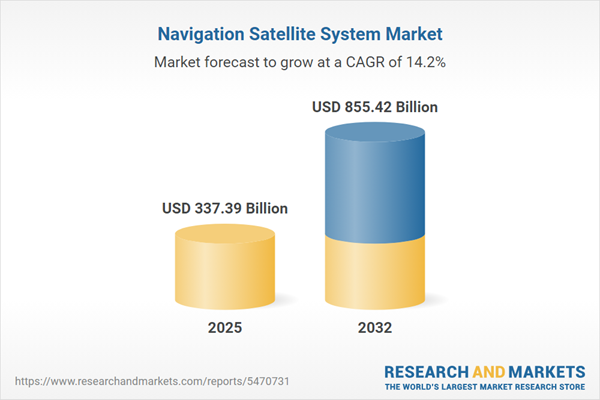Speak directly to the analyst to clarify any post sales queries you may have.
Navigation satellite system solutions are reshaping enterprise operations by driving precision, compliance, and agility across digital infrastructures. As organizations confront growing regulatory obligations and complexities, there is increasing demand for platforms that secure geolocation accuracy while enabling responsive asset management and sustained business performance.
Market Snapshot: Navigation Satellite System Market Growth
The navigation satellite system market is experiencing substantial growth, backed by widespread adoption across transport, defense, telecommunications, and agriculture. In 2024, the global market achieved USD 295.71 billion, and is projected to reach USD 337.39 billion in 2025. A compound annual growth rate of 14.19% supports the outlook for expansion to USD 855.42 billion by 2032. This upward trend is driven by ongoing investment in digital infrastructure, continual innovation, and dynamic regulatory environments, making adaptability and precision critical for stakeholders.
Scope & Segmentation of the Navigation Satellite System Market
The report equips senior decision-makers with detailed insights for optimizing navigation satellite system deployments, focusing on technology integration and strategic alignment within complex operational frameworks. Market segmentation covers key solution categories, deployment scenarios, and regional influences to inform technology and investment planning.
- Component: Includes antennas, single-band and multi-band receivers, navigation software, mapping solutions, and fleet management platforms, enabling continuous tracking and efficient enterprise workflows.
- Platform: Spans aircraft, unmanned aerial vehicles, ground and rail vehicles, shipping vessels, and public sector safety systems, each tailored to distinct compliance and operational needs across both private and public organizations.
- Application: Encompasses avionics navigation, autonomous vehicle guidance, defense communications, precision agriculture, logistics, asset management, and professional surveying, supporting enhanced operational accuracy and integrity.
- Regions: Adoption patterns vary significantly due to regulatory context, technology readiness, and investment levels, with strategic differentiation required to address the Americas, Europe, Middle East, Africa, and Asia-Pacific markets.
- Key Companies: The competitive landscape features organizations such as Lockheed Martin, Raytheon Technologies, Northrop Grumman, Airbus SE, Boeing, Thales, L3Harris Technologies, BAE Systems, Honeywell International, and Mitsubishi Electric, each advancing integration and standards across the sector.
Leaders are encouraged to track the evolution of both hardware and software, anticipate changes premised on national and international regulations, and explore alliances that foster greater resilience and scalability in their navigation satellite solutions.
Key Takeaways for Senior Decision-Makers
- Adopting multi-constellation navigation solutions enhances continuity in geolocation services and maintains operations through disruptions.
- Combining satellite navigation with 5G and IoT connectivity enables real-time awareness and facilitates flexible digital strategies.
- Employing modular hardware accelerates asset deployment and supports dynamic organizational needs in volatile market conditions.
- Partnering with technology providers and cybersecurity experts fortifies reliability and addresses region-specific compliance challenges.
- Industry-wide cooperation allows for technology benchmarking and supports more efficient entry into new sectors and geographic markets.
- Prioritizing robust compliance and cybersecurity ensures protection of operational data and compliance across functions and locations.
Tariff Impact on Supply Chains and Market Dynamics
U.S. tariffs on imported navigation system components have driven organizations to diversify supplier networks and expand domestic manufacturing capabilities. This shift, while potentially increasing some costs, reinforces supply chain visibility and strengthens resilience. Strategic reevaluation of vendor relationships and updates to distribution approaches equip enterprises to better manage risk in a changing, trade-sensitive landscape.
Methodology & Data Sources
Research is based on review of authoritative industry sources, patent developments, and regulatory updates. Direct feedback was collected from leading system integrators and executive decision-makers, yielding practical insight on technology deployment and evolving strategic priorities.
Why This Report Matters
- Empowers executives to align satellite navigation system investments with next-generation technologies and shifting compliance mandates.
- Delivers actionable regional and sector intelligence for more precise technology adoption and capital allocation.
- Enables leaders to enhance cybersecurity and optimize supply chain management amid changing market and regulatory landscapes.
Conclusion
Ultimately, integrating advanced navigation satellite system capabilities bolsters business agility and compliance, supporting ongoing operational excellence in a globally interconnected environment.
Additional Product Information:
- Purchase of this report includes 1 year online access with quarterly updates.
- This report can be updated on request. Please contact our Customer Experience team using the Ask a Question widget on our website.
Table of Contents
3. Executive Summary
4. Market Overview
7. Cumulative Impact of Artificial Intelligence 2025
Companies Mentioned
The companies profiled in this Navigation Satellite System market report include:- Lockheed Martin Corporation
- Raytheon Technologies Corporation
- Northrop Grumman Corporation
- Airbus SE
- The Boeing Company
- Thales S.A.
- L3Harris Technologies, Inc.
- BAE Systems plc
- Honeywell International Inc.
- Mitsubishi Electric Corporation
Table Information
| Report Attribute | Details |
|---|---|
| No. of Pages | 181 |
| Published | October 2025 |
| Forecast Period | 2025 - 2032 |
| Estimated Market Value ( USD | $ 337.39 Billion |
| Forecasted Market Value ( USD | $ 855.42 Billion |
| Compound Annual Growth Rate | 14.1% |
| Regions Covered | Global |
| No. of Companies Mentioned | 11 |









